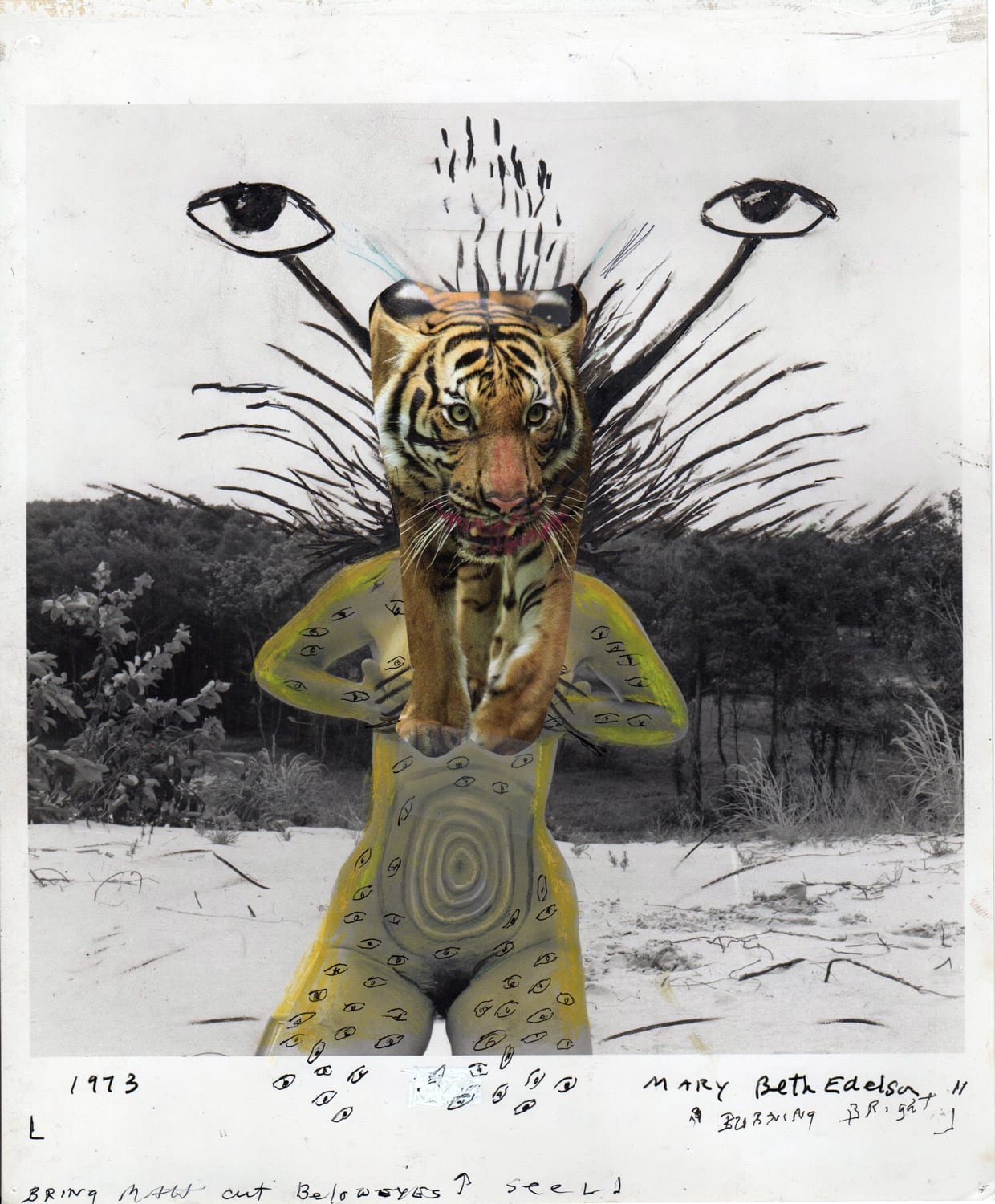「強大且狂熱的」:第一代女性主義藝術家Mary Beth Edelson 終究尋找到屬於自己的最佳位置
David Lewis展廳裡發現她的矯飾攝影
登入並訂閱巴塞爾藝術展專題故事
I can’t remember exactly where and when I first saw Mary Beth Edelson’s Some Living American Women Artists (1972), a collage of female artists’ faces cut from photographs to replace those of Jesus and the apostles in a black and white reproduction of Leonardo da Vinci’s The Last Supper (Georgia O’Keefe appears as a benevolent Christ; Agnes Martin, Alice Neel and Yoko Ono are also pictured).But in discovering the broader work of the artist – represented by New York’s David Lewis gallery – I was jolted by not only lost familiarity with the piece, but a sense that Edelson’s oeuvre is at last settling into its ideal time and place.
For many reasons – one of them perhaps a long-awaited response to western-world political situations that can no longer accommodate conformity and complacency – art history’s narratives have broadened in the past few years. ‘The canon has been revised, and Mary Beth is a big part of it,’ gallerist Lewis told me during a mid-lockdown telephone conversation (Edelson, now 87, is currently living in an assisted-living facility and no longer able to do interviews). When Lewis – who is showing a selection of her altered photographs in Art Basel’s Online Viewing Rooms – first worked with Edelson in 2011, in a group show at a now-defunct gallery, he ‘got some light applause from the downtown community,’ he says. ‘But six years later, the audience was ready to take this seriously as major art.’ Lewis is referring to a solo show of Edelson’s work that he mounted in 2017, called ‘The Devil Giving Birth to the Patriarchy’,which overwhelmingly resonated with collectors, viewers, critics such as The New York Times’ Roberta Smith, and institutions. Feminist art has at last become less an afterthought to art history and more an integral component.
Encompassing painting, sculpture, printmaking, photography, drawing, and performance, Edelson’s work is bold, ritualistic, and risky. Her methods were both profoundly individual (she often performed solo rituals) and community-based (she was part of New York’s women-only AIR Gallery, which was founded in 1972, orchestrated group performances, and was an avid activist). She connected not only to the everyday struggles of being a woman in a man’s world, but also to the realms of myths and archetypes, and psychology. In the early 1970s, she was taken by Carl Jung’s ideas of collective consciousness but ultimately found them too patriarchal; later, she turned her focus to goddess worship in various ancient cultures. Informing and infusing her work during that decade are Kali, Baubo, and Minoan snake and Egyptian bird goddesses. In a research journal from the time, she asks herself in a handwritten note: ‘What happened? How did we get taken over? When did goddess worshipping actually cease, and why?’
This inquiry is reflected in her ‘Woman Rising’ series (1973-74), in which the artist photographed her naked body during private rituals performed in arid landscapes. She later painted or collaged the silver-print documentation, creating identities atop her own: ancient goddesses brandishing decapitated heads, Edelson wearing critic Lucy Lippard’s face as a kind of Venus of Willendorf, Edelson being Wonder Woman, or simply herself, arms up and with circles drawn around her navel and areolae, before a rising yellow crescent moon or radiating lines reaching to the sky. In the mid-1970s, she made pilgrimages to neolithic goddess sites in the former Yugoslavia, and again photographed private rituals, this time blurring her own image within caves or waterfalls with time-lapse photography. The ghostly results are less overtly fierce but no less powerful. And then came the Great Goddess Cut-Outs (1974-75): life-size acrylic-on-plywood odes to goddess culture with simple forms and markings – triangles, circles, painted hatch marks – hearkening to primitivism and standing like powerful totem-sentries and connecting, in her own words, ‘to ancient sisters.’ In 2019, Lewis showed 18 of them at his gallery; most had not been seen since a mid-1970s exhibition at the Corcoran Gallery of Art in Washington, DC.

Edelson’s later work turned to Hollywood ‘goddesses,’ then tabloid ones. ‘The Devil Giving Birth to the Patriarchy’, the last exhibition in which the artist actively contributed, featured a reference to Lorena Bobbitt, the woman who notoriously severed the penis of her abusive husband in the early 1990s. Kali Bobbitt (1994), a multiarmed mannequin in leather fetish garb and stockings, brandishes in her upper hands a knife and a representation of the cut organ; she wears a belt of knives and a bracelet of tiny penises. Here, but also in videos from the early 2010s of a 70-something Edelson, it’s clear that, beyond her anger, the artist has a wicked sense of humor (Lippard once stated that Edelson’s work embodied both ‘political rage and life-giving affirmation’). During the same period, before opening his gallery, Lewis often had long talks with the artist in a sprawling, old-school loft studio in SoHo, where she worked for more than 40 years. ‘I didn’t realize how fortunate I was to be spending time with her when I was finishing graduate school,’ he says. ‘I felt like Keanu Reeves in The Matrix, downloading her information. It was wonderful.’ Considering such a knowledge transfer in appropriately ritualistic terms, it’s as though Lewis was, in a way, initiated by an elder matriarch.
Mary Beth Edelson's works could be viewed in David Lewis' virtual booth in Art Basel's Online Viewing Rooms, June 19-26, 2020.

